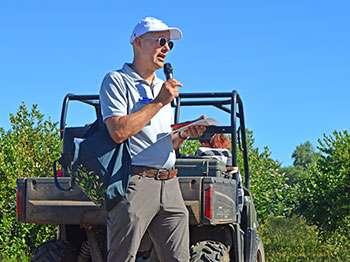Oregon Blueberry Growers, Beekeepers Develop Protocol
The blueberry industry is poised to be the fourth industry in Oregon to develop a bee protection protocol.
Speaking at the OSU Blueberry Field Day in Aurora July 24, Oregon State University Pollinator Health Specialist Andony Melathopoulos said growers, beekeepers and others have pretty much ironed out the protocols.
 |
Speaking at the OSU Blueberry Field Day, OSU Pollinator Health Specialist Andony Melathopoulos said to expect a bee protection protocol for blueberries to be ready by the Oregon Blueberry Conference, scheduled Feb. 4, 2025, in Salem. |
“This protocol will be ready by the February Conference,” Melathopoulos said. “We are going to have a draft and go through that after harvest with the growers and the beekeepers.”
Key aspects of the protocol include colony placement and timing, and when growers should start communicating with beekeepers.
“There was an agreement to contact the beekeepers at the pink stage of the flowering,” Melathopoulos said. That timing will give beekeepers a good sense of when the bloom will be coming on, he said, and when they should be ready to deliver the colonies.
“There was also discussion about moving colonies out,” Melathopoulos said, noting that beekeepers have stated that blueberries are the longest set that they work with and that they typically are anxious to move colonies out of blueberries and into clover seed pollination and radish seed pollination.
One idea that came out of the protocol discussions was to consider drawing down the number of colonies used in blueberries toward the end of bloom.
Protocol development also included discussions around colony placement, particularly in light of research that has shown no negative impact on pollination when clumping colonies away from blueberry plants rather than dispersing them around fields.
“Research has showed these large clumps of colonies are just as effective, if not more effective under good conditions, than spreading all the colonies out.”
|
“Research has showed these large clumps of colonies are just as effective, if not more effective under good conditions, than spreading all the colonies out,” Melathopoulos said. Clumping colonies can reduce exposure to fungicides and is more cost effective and less labor intensive for beekeepers.
As for fungicide use, the protocol generally calls for growers to apply them during the evening or on days when the temperature is not expected to rise about fifty degrees Fahrenheit, Melathopoulos said.
Interested parties can hear more about the Blueberry Bee Protection Protocol at the Oregon Blueberry Conference, scheduled February 4, 2025, at the Salem Convention Center.